The Tidal Stream Energy Resource of the Fromveur Strait—A Review
Abstract
1. Introduction
2. Materials and Methods
2.1. Observations
2.2. Predictions
3. General Features
3.1. Bathymetry and Seabed Composition
3.2. Tidal Hydrodynamics
3.3. Meteo-Oceanographic Conditions
4. Resource Assessments
4.1. Tide-Induced Variability
4.1.1. Tidal Asymmetry
4.1.2. Spring-Neap Tidal Variability
4.2. Superimposed Effects of Waves
5. Energy Extraction
5.1. Environmental Impact Studies
5.1.1. Effects on Tidal Current and Bottom Shear Stress
5.1.2. Effects on the Lagrangian Residual Circulation
5.1.3. Effects on Water Renewal
5.2. Sizing and Optimization Study
5.2.1. Optimization of Turbine Location According to Technological Options
5.2.2. Turbine Wake Interactions and Array Configuration
5.2.3. Hybrid Energy Systems
6. Conclusions
- Tidal analysis can expose the temporal variability of the available resource. The exploitation of high-resolution tidal current harmonic databases identified therefore (i) areas with diurnal inequalities (characterized by unequal magnitude of current velocities between peak ebb and flood) and (ii) areas with lunar inequalities (characterized by noticeable differences in current magnitudes between neap and spring conditions). Thus, the Fromveur Strait exhibited a central divergence region with reduced semidiurnal asymmetry which appeared desirable for the implementation of horizontal-axis turbines. In comparison with offshore locations of western Brittany, this central area exhibited furthermore low spring-neap variability, thus promoting this location for tidal energy conversion.
- The Fromveur Strait was characterized by strong wave and current interactions, revealed by the tidal modulations of the significant wave height in surrounding wave buoy stations. These effects, quite typical of tidal straits exposed to oceanic waves, were reinforced by depth- and current-induced refractions. Advanced numerical resource assessments coupling wave and tidal circulation models exhibited a reduction by around of the mean spring tidal power density during storm conditions. Waves were furthermore increasing the lateral gradient of tidal power density identified between the island of Ushant and islets and shoals of the northern part of Molène archipelago.
- A series of regional impact studies were conducted by relying on the distributed drag method in high-resolution numerical simulations of the tidal circulation off western Brittany. For a full energy extraction scenario, predictions exhibited noticeable reduction, over , of depth-averaged currents magnitudes at several kilometers from the array. These modifications impacted also the bottom shear stresses and the tide-induced Lagrangian circulation, thus suggesting potential effects on surrounding seabed sand features (in particular the sand bank of the Four in the north-eastern part of the archipelago).
- The Ushant-Molène archipelago showed, however, important ecological robustness to hydrodynamic changes induced by operating turbines. This environment was thus characterized by strong renewal capacity of marine waters with an evacuation of nearly of the initial water mass in less than three days. The long-term evolution exhibited, however, residual values of an initial tracer concentration after a period of several months. Simulations suggested negligible turbines effects on the renewal capacity of this marine environment. Nevertheless, the extraction of tidal stream energy from the strait increased locally the tracer concentration in the early days of tracers release. Local trapping areas were thus identified in the vicinity of Lagrangian residual eddies both upstream and downstream the strait but vanished after a period of two months.
- A refined characterization of the spatial and temporal variability of tidal current velocity is a prerequesite to optimize the technological option choices and location of tidal stream turbines suitable for yawed and/or fixed-axis devices. Beyond these preliminary investigations, an advanced assessment of the generated technical resource is required to complete the design stage of a tidal farm, thus simulating the local interactions between turbines’ wakes and the ambient flow field.
- In the Fromveur Strait, refined simulations of turbine wake interactions suggested to reduce the lateral spacing between devices, thus restricting wake overlap and increasing the energy produced during peak flood characterized by misalignment of tidal currents with respect to array orientation.
- This optimized array layout has, however, to be configured with respect to the hybridization of tidal stream turbines with other resources and energy storage systems, this in order to mitigate short- and more long-term fluctuations of power supply injected in the grid balance. Investigations conducted in the island of Ushant suggested to rely on Energy Storage Sytems to restrict the short term power fluctuation in power production. Advanced sizing and optimization studies promoted furthermore the combination of tidal turbines with wind devices, diesel generators, and pumped hydroelectric storage to secure the energy distribution, guarantee the cost of renewable energy and minimize carbon dioxide emissions for energy production of this stand-alone marine island territory.
Author Contributions
Funding
Acknowledgments
Conflicts of Interest
References
- Authorities & Government. Tides Wash Away OpenHydro. 2020. Available online: https://www.offshore-energy.biz/tides-wash-away-openhydro/ (accessed on 17 December 2020).
- Lafleur, C.; Truelove, W.A.; Cousineau, J.; Hiles, C.E.; Buckham, B.; Crawford, C. A screening method to quantify the economic viability of off-grid in-stream tidal energy deployment. Renew. Energy 2020, 159, 610–622. [Google Scholar] [CrossRef]
- Guillou, N.; Neill, S.; Thiébot, J. Spatio-temporal variability of tidal-stream energy in north-western Europe. Philos. Trans. R. Soc. A 2020, 378. [Google Scholar] [CrossRef] [PubMed]
- Simec Atlantis Energy. Tidal Stream Projects MeyGen. 2020. Available online: https://simecatlantis.com/projects/meygen/ (accessed on 17 December 2020).
- EMEC. The European Marine Energy Centre LTD. 2020. Available online: http://www.emec.org.uk (accessed on 17 December 2020).
- Sabella. Sabella D10—France. 2020. Available online: https://www.sabella.bzh/en/projects/d10 (accessed on 17 December 2020).
- CMN (Constructions Mécanique de Normandie). 2020. Available online: https://cmn-group.com/hydroquest-ocean-6-mois-de-fonctionnement-continu/ (accessed on 17 December 2020).
- Orbital Marine Power. 2020. Available online: https://orbitalmarine.com/ (accessed on 17 December 2020).
- Robins, P.; Neill, S.; Lewis, M.; Ward, S. Characterising the spatial and temporal variability of the tidal-stream energy resource over the northwest European shelf seas. Appl. Energy 2015, 147, 510–522. [Google Scholar] [CrossRef]
- Guillou, N.; Neill, S.P.; Robins, P.E. Characterising the tidal stream power resource around France using a high-resolution harmonic database. Renew. Energy 2018, 123, 706–718. [Google Scholar] [CrossRef]
- Hashemi, M.; Neill, S.; Robins, P.; Davies, A.; Lewis, M. Effect of waves on the tidal energy resource at a planned tidal stream array. Renew. Energy 2015, 75, 626–639. [Google Scholar] [CrossRef]
- Guillou, N.; Thiébot, J.; Chapalain, G. Turbines’ effects on water renewal within a marine tidal stream energy site. Energy 2019, 189, 116113. [Google Scholar] [CrossRef]
- SHOM. Morpho-Sédimentologie et Courants de Marée 3D du Passage du Fromveur. 2020. Available online: https://www.data.gouv.fr/en/datasets/morpho-sedimentologie-et-courants-de-maree-3d-du-passage-du-fromveur/#_ (accessed on 17 December 2020).
- Mariette, V.; Thomas, N.; Cochin, V.; Guichoux, Y.; Ardhuin, F. Premiers résultats de l’expérience SURLITOP (Surveillance Littorale Opérationnelle. Annu. Navig. 2006, 54, 45–57. [Google Scholar]
- Sentchev, A.; Forget, P.; Barbin, Y.; Yaremchuk, M. Surface circulation in the Iroise Sea (W. Brittany) from high resolution HF radar mapping. J. Mar. Syst. 2013, 109–110, S153–S168. [Google Scholar] [CrossRef]
- Hervouet, J.M. Hydrodynamics of Free Surface Flows, Modelling with the Finite Element Method; Cambridge University Press: Cambridge, UK, 2007; p. 311. [Google Scholar]
- El Tawil, T.; Charpentier, J.; Benbouzid, M. Tidal energy site characterization for marine turbine optimal installation: Case of the Ouessant Island in France. Int. J. Mar. Energy 2017, 18, 57–64. [Google Scholar] [CrossRef]
- El Tawil, T.; Guillou, N.; Charpentier, J.F.; Benbouzid, M. On Tidal Current Velocity Vector Time Series Prediction: A Comparative Study for a French High Tidal Energy Potential Site. J. Mar. Sci. Eng. 2019, 7, 46. [Google Scholar] [CrossRef]
- Tondut, J.; Tawil, T.E.; Thiébot, J.; Guillou, N.; Benaouicha, M. A comparative study for tidal current velocity prediction using simplified and fast algorithms. Appl. Ocean Res. 2020, 104, 102346. [Google Scholar] [CrossRef]
- Lazure, P.; Dumas, F. An external-internal mode coupling for a 3D hydrodynamical model for applications at regional scale (MARS). Adv. Water Resour. 2008, 31, 233–250. [Google Scholar] [CrossRef]
- Pineau-Guillou, L. PREVIMER Validation des Atlas de Composantes Harmoniques de Hauteurs et Courants de Marée, Technical Report ODE/DYNECO/PHYSED/2013-03 version 1.0; IFREMER: Plouzané, France, 2013. [Google Scholar]
- Guillou, N.; Thiébot, J. The impact of seabed rock roughness on tidal stream power extraction. Energy 2016, 112, 762–773. [Google Scholar] [CrossRef]
- Guillou, N.; Chapalain, G.; Neill, S.P. The influence of waves on the tidal kinetic energy resource at a tidal stream energy site. Appl. Energy 2016, 180, 402–415. [Google Scholar] [CrossRef]
- Guillou, N.; Chapalain, G. Assessing the impact of tidal stream energy extraction on the Lagrangian circulation. Appl. Energy 2017, 203, 321–332. [Google Scholar] [CrossRef]
- Michelet, N.; Guillou, N.; Chapalain, G.; Thiébot, J.; Guillou, S.; Goward Brown, A.; Neill, S. Three-dimensional modelling of turbine wake interactions at a tidal stream energy site. Appl. Ocean Res. 2020, 95, 102009. [Google Scholar] [CrossRef]
- Guillou, N.; Thiébot, J. Environmental impact of a tidal stream farm: Predictions sensitivity to bottom roughness. In 15èmes Journées de l’Hydrodynamique; ENSTA Bretagne, Ecole Navale et IFREMER: Brest, France, 2016. [Google Scholar]
- Egbert, G.; Bennett, A.; Foreman, M. TOPEX/POSEIDON tides estimated using a global inverse model. J. Geophys. Res. 1994, 99, 24821–24852. [Google Scholar] [CrossRef]
- Guillou, N.; Chapalain, G. Evaluating the Effects of Tidal Turbines on Water-Mass Transport with the Lagrangian Barycentric Method. In Estuaries and Coastal Zones in Times of Global Change; Springer: Singapore, 2020; pp. 217–233. [Google Scholar]
- Shchepetkin, A.F.; McWilliams, J.C. The regional oceanic modelling system (ROMS): A split-explicit, free-surface, topography-following-coordinate oceanic model. Ocean Model. 2005, 9, 347–404. [Google Scholar] [CrossRef]
- Hamdi, A.; Vasquez, M.; Populus, J. Cartographie des Habitats Physiques Eunis—Côtes de France; Technical Report DYNECO/AG/10-26/JP; IFREMER: Brest, France, 2010. [Google Scholar]
- Thiébaut, M.; Sentchev, A. Estimation of Tidal Stream Potential in the Iroise Sea from Velocity Observations by High Frequency Radars. Special Issue: European Geosciences Union General Assembly 2015—Division Energy, Resources and Environment. Energy Procedia 2015, 76, 17–26. [Google Scholar] [CrossRef]
- Thiébaut, M.; Sentchev, A. Asymmetry of tidal currents off the W.Brittany coast and assessment of tidal energy resource around the Ushant Island. Renew. Energy 2017, 105, 735–747. [Google Scholar] [CrossRef]
- Pingree, R.D.; Holligan, P.; Head, R. Survival of dinoflagellate blooms in the western English Channel. Nature 1977, 265, 266–269. [Google Scholar] [CrossRef]
- Guillou, N.; Chapalain, G.; Duvieilbourg, E. Modelling impact of bottom roughness on sea surface temperature in the Sea of Iroise. Cont. Shelf Res. 2013, 54, 80–92. [Google Scholar] [CrossRef][Green Version]
- Muller, H.; Blanke, B.; Dumas, F.; Lekien, F.; Mariette, V. Estimating the Lagrangian residual circulation in the Iroise Sea. J. Mar. Syst. 2009, 78, S17–S36. [Google Scholar] [CrossRef]
- Bentamy, A.; Croize-Fillon, D. Spatial and temporal characteristics of wind and wind power off the coasts of Brittany. Renew. Energy 2014, 66, 670–679. [Google Scholar] [CrossRef]
- Mattarolo, G.; Lafon, F.; Benoit, M. Wave energy resource of the French coasts: The ANEMOC database applied to the energy yield evaluation of wave energy converters. In Proceedings of the 8th European Wave and Tidal Energy Conference, Uppsala, Sweden, 7–10 September 2009. [Google Scholar]
- Guillou, N.; Chapalain, G. Numerical modelling of nearshore wave energy resource in the Sea of Iroise. Renew. Energy 2015, 83, 942–953. [Google Scholar] [CrossRef]
- Guillou, N. Evaluation of wave energy potential in the Sea of Iroise with two spectral models. Ocean Eng. 2015, 106, 141–151. [Google Scholar] [CrossRef]
- Guillou, N. Modelling effects of tidal currents on waves at a tidal stream energy site. Renew. Energy 2017, 114, 180–190. [Google Scholar] [CrossRef]
- Black and Veatch. UK Tidal Current Resource and Economics; Technical Report, Commissioned by the Carbon Trust and Npower, Project Number 121393; Black and Veatch: Overland Park, KS, USA, 2011. [Google Scholar]
- Pingree, R.D.; Griffiths, D.K. Sand transport paths around the British Isles resulting from M2 and M4 tidal interactions. J. Mar. Biol. Assoc. UK 1979, 59, 497–513. [Google Scholar] [CrossRef]
- Friedrichs, C.T.; Aubrey, D.G. Non-linear tidal distortion in shallow well-mixed estuaries: A synthesis. Estuar. Coast. Shelf Sci. 1988, 27, 521–545. [Google Scholar] [CrossRef]
- Guillou, N.; Chapalain, G. Tidal Turbines’ Layout in a Stream with Asymmetry and Misalignment. Energies 2017, 10, 1892. [Google Scholar] [CrossRef]
- Grant, W.; Madsen, O. Combined wave and current interaction with a rough bottom. J. Geophys. Res. 1979, 84, 1797–1808. [Google Scholar] [CrossRef]
- Longuet-Higgins, M.; Stewart, R. Radiation stresses in water waves; a physical discussion, with applications. Deep Sea Res. Oceanogr. Abstr. 1964, 11, 529–562. [Google Scholar] [CrossRef]
- Neill, S.; Jordan, J.; Couch, S. Impact of tidal energy convertor (TEC) arrays on the dynamics of headland sand banks. Renew. Energy 2012, 37, 387–397. [Google Scholar] [CrossRef]
- Plew, D.; Stevens, C. Numerical modelling of the effects of turbines on currents in a tidal channel - Tory Channel, New Zealand. Renew. Energy 2013, 57, 269–282. [Google Scholar] [CrossRef]
- Ahmadian, R.; Falconer, R.; Bockelmann-Evans, B. Far-field modelling of the hydro-environmental impact of tidal stream turbines. Renew. Energy 2012, 38, 107–116. [Google Scholar] [CrossRef]
- Ahmadian, R.; Falconer, R. Assessment of array shape of tidal stream turbines on hydro-environmental impacts and power output. Renew. Energy 2012, 44, 318–327. [Google Scholar] [CrossRef]
- Kadiri, M.; Ahmadian, R.; Bockelmann-Evans, B.; Rauen, W.; Falconer, R. A review of the potential water quality impacts of tidal renewable energy systems. Renew. Sustain. Energy Rev. 2012, 16, 329–341. [Google Scholar] [CrossRef]
- Salomon, J.C.; Guéguéniat, P.; Orbi, A.; Baron, Y. A Lagrangian model for long-term tidally induced transport and mixing. Verification by artificial radionuclide concentrations. In Radionuclides: A Tool for Oceanography; Guary, J.C., Guéguéniat, P., Pentreath, R.J., Eds.; Elsevier Applied Science Publishers: London, UK; New York, NY, USA, 1988; pp. 384–394. [Google Scholar]
- Salomon, J.C.; Breton, M. An atlas of long-term currents in the Channel. Oceanol. Acta 1993, 16, 439–448. [Google Scholar]
- Orbi, A.; Salomon, J.C. Dynamique de marée dans le Golfe Normand-Breton. Oceanol. Acta 1988, 11, 55–64. [Google Scholar]
- Phelps, J.J.C.; Polton, J.A.; Souza, A.J.; Robinson, L.A. Hydrodynamic timescales in a hyper-tidal region of freshwater influence. Cont. Shelf Res. 2013, 63, 13–22. [Google Scholar] [CrossRef]
- Zhou, Z.; Benbouzid, M.; Charpentier, J.F.; Scuiller, F.; Tang, T. Developments in large marine current turbine technologies—A review. Renew. Sustain. Energy Rev. 2017, 71, 852–858. [Google Scholar] [CrossRef]
- Paboeuf, S.; Sun, P.Y.K.; Macadré, L.; Malgorn, G. Power Performance Assessment of the Tidal Turbine Sabella D10 Following IEC62600-200. In Proceedings of the ASME 2016 35th International Conference on Ocean, Offshore and Arctic Engineering, Busan, Korea, 19–24 June 2016; Volume 6. [Google Scholar]
- Roc, T.; Greaved, D.; Thyng, K.M.; Conley, D.C. Tidal turbine representation in an ocean circulation model: Towards realistic application. Ocean Eng. 2014, 78, 95–111. [Google Scholar] [CrossRef]
- Bai, L.; Spence, R.R.; Dudziak, G. Investigation of the influence of array arrangement and spacing on Tidal Energy Converter (TEC) performance using a 3-dimensional CFD model. In Proceedings of the 8th European Wave and Tidal Energy Conference Series, Uppsala, Sweden, 7–10 September 2009; pp. 654–660. [Google Scholar]
- Jonsdottir, G.M.; Milano, F. Modeling of Short-Term Tidal Power Fluctuations. IEEE Trans. Sustain. Energy 2020, 11, 2337–2344. [Google Scholar] [CrossRef]
- Zhou, Z.; Scuiller, F.; Charpentier, J.F.; Benbouzid, M.E.H.; Tang, T. Power smoothing control in a grid-connected marine current turbine system for compensating swell effect. IEEE Trans. Sustain. Energy 2013, 4, 816–826. [Google Scholar] [CrossRef]
- Trabelsi, M.; Charpentier, J.; Scuiller, F.; Franquet, C.; Nicolas, E. Energetic Macroscopic Representation and Inversion-Based Control of a Grid-Connected MCT Power Generation System with Super-Capacitor Based Energy Storage Unit in Ushant Island. In Proceedings of the 2019 Offshore Energy and Storage Summit (OSES), Brest, France, 10–12 July 2019; pp. 1–9. [Google Scholar] [CrossRef]
- Trabelsi, M.; Charpentier, J.; Scuiller, F. Power Smoothing in MCT System with Supercapacitor Based Energy Storage for Islanded Grid. In Proceedings of the IECON 2019—45th Annual Conference of the IEEE Industrial Electronics Society, Lisbon, Portugal, 14–17 October 2019; Volume 1, pp. 7004–7009. [Google Scholar] [CrossRef]
- Molina, S.; Nicolas, E.; Trabelsi, M.; Scuiller, F.; Charpentier, J.; Franquet, C. A Real Scale Prototype to Smooth Short-Time Power Fluctuations of Marine Renewable Energy Sources-Uliss.EMR Project. In Proceedings of the 2019 Offshore Energy and Storage Summit (OSES), Brest, France, 10–12 July 2019; pp. 1–6. [Google Scholar] [CrossRef]
- Zhou, Z.; Benbouzid, M.E.H.; Charpentier, J.F.; Scuiller, F. Hybrid Diesel/MCT/Battery Electricity Power Supply System for Power Management in Small Islanded Sites: Case Study for the Ouessant French Island. In Smart Energy Grid Design for Island Countries; Green Energy and Technology Series; Springer International Publishing: New York, NY, USA, 2017; Chapter 13; pp. 415–445. [Google Scholar]
- El Tawil, T.; Charpentier, J.F.; Benbouzid, M. Sizing and rough optimization of a hybrid renewable-based farm in a stand-alone marine context. Renew. Energy 2018, 115, 1134–1143. [Google Scholar] [CrossRef]
- Zia, M.; Elbouchikhi, E.; Benbouzid, M.; Guerrero, J.M. Energy Management System for an Islanded Microgrid With Convex Relaxation. IEEE Trans. Ind. Appl. 2019, 55, 7175–7185. [Google Scholar] [CrossRef]
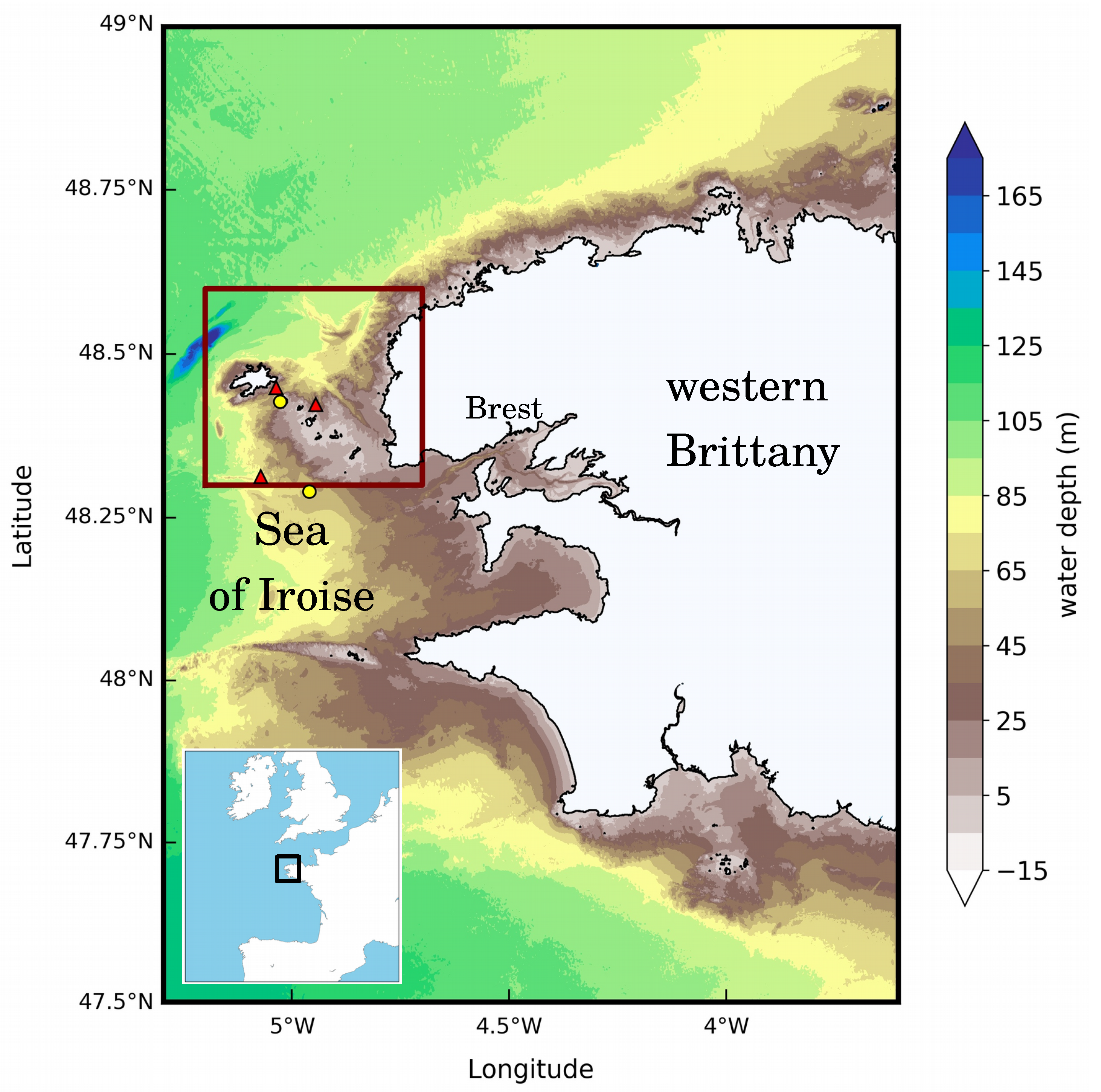

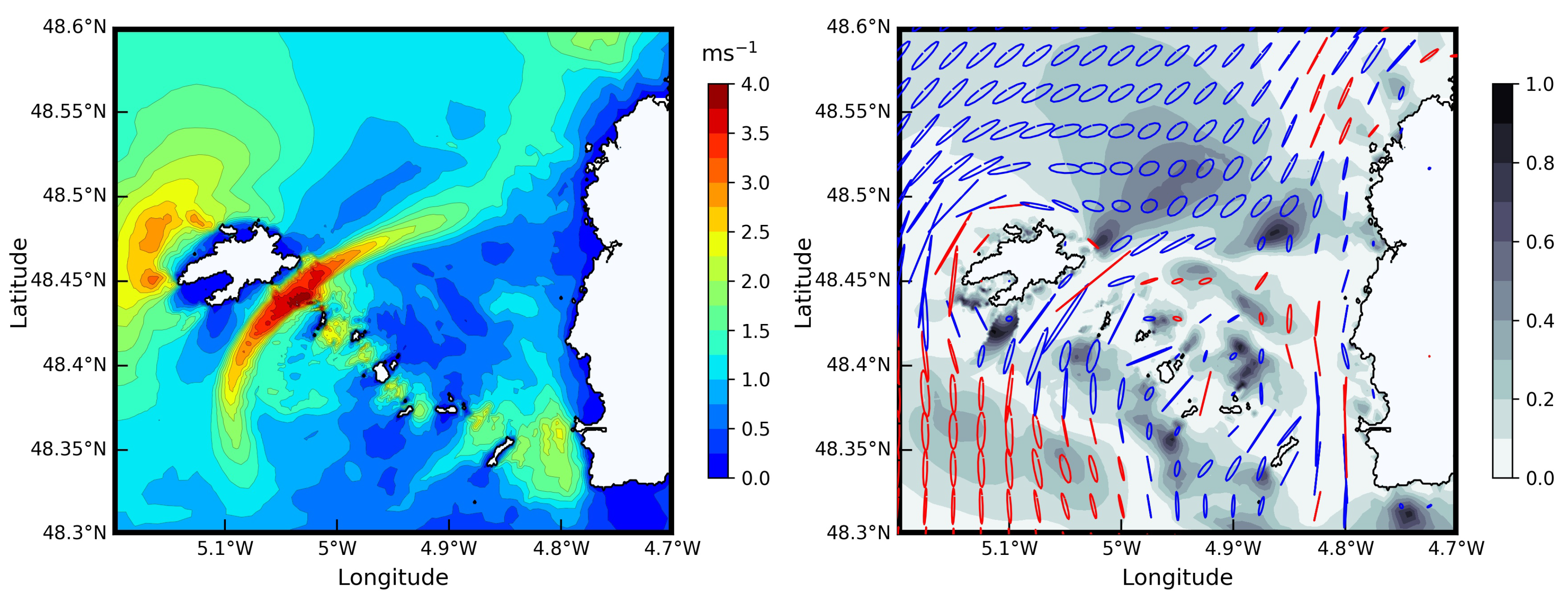
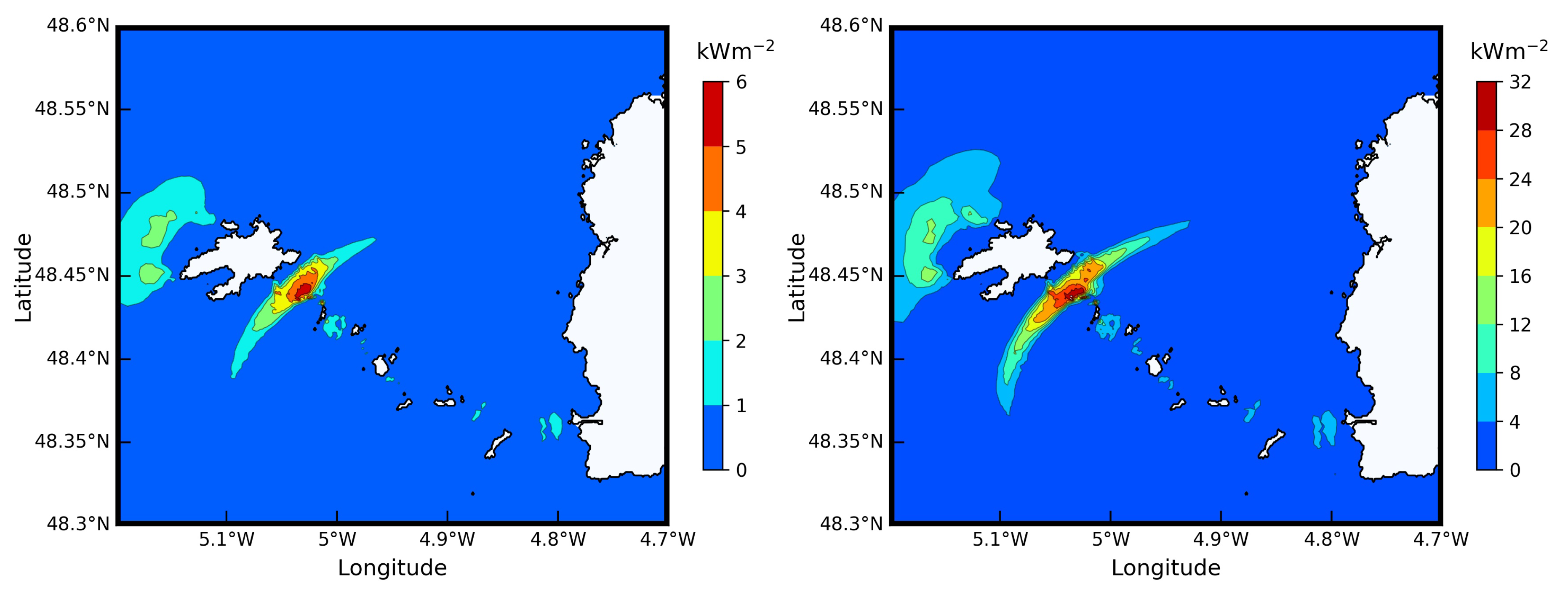
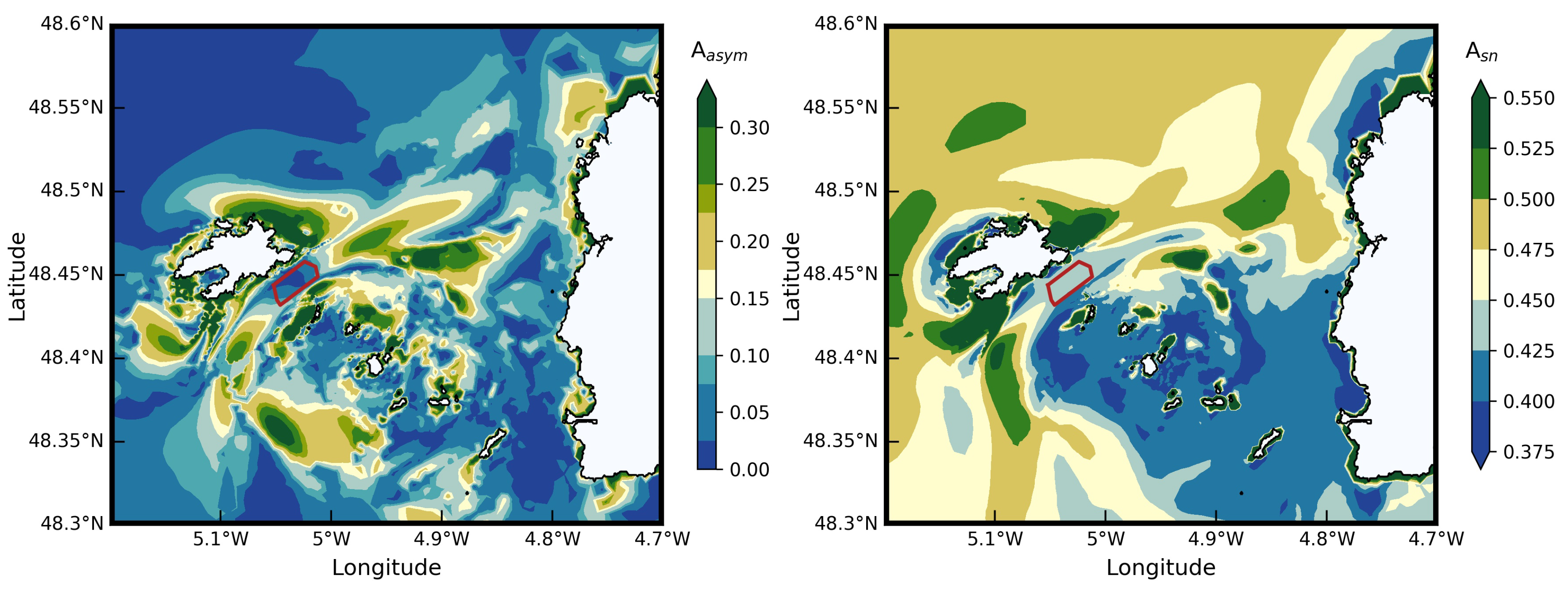
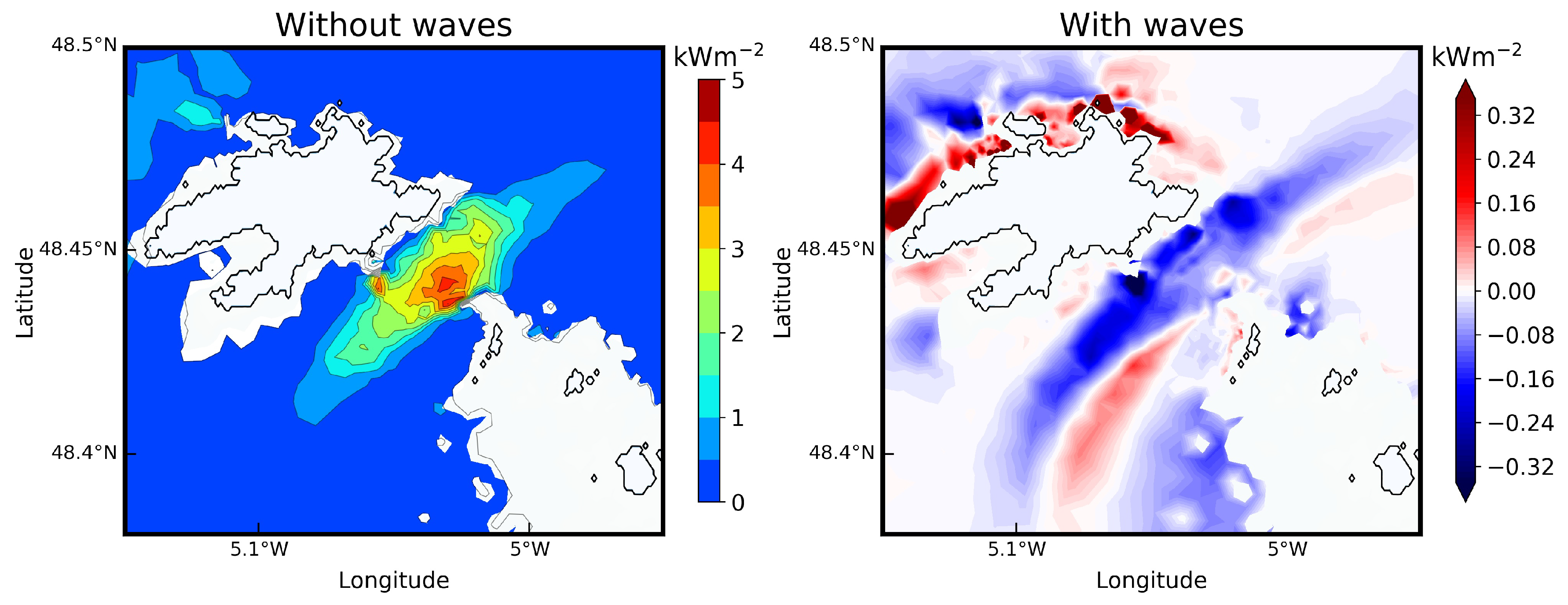


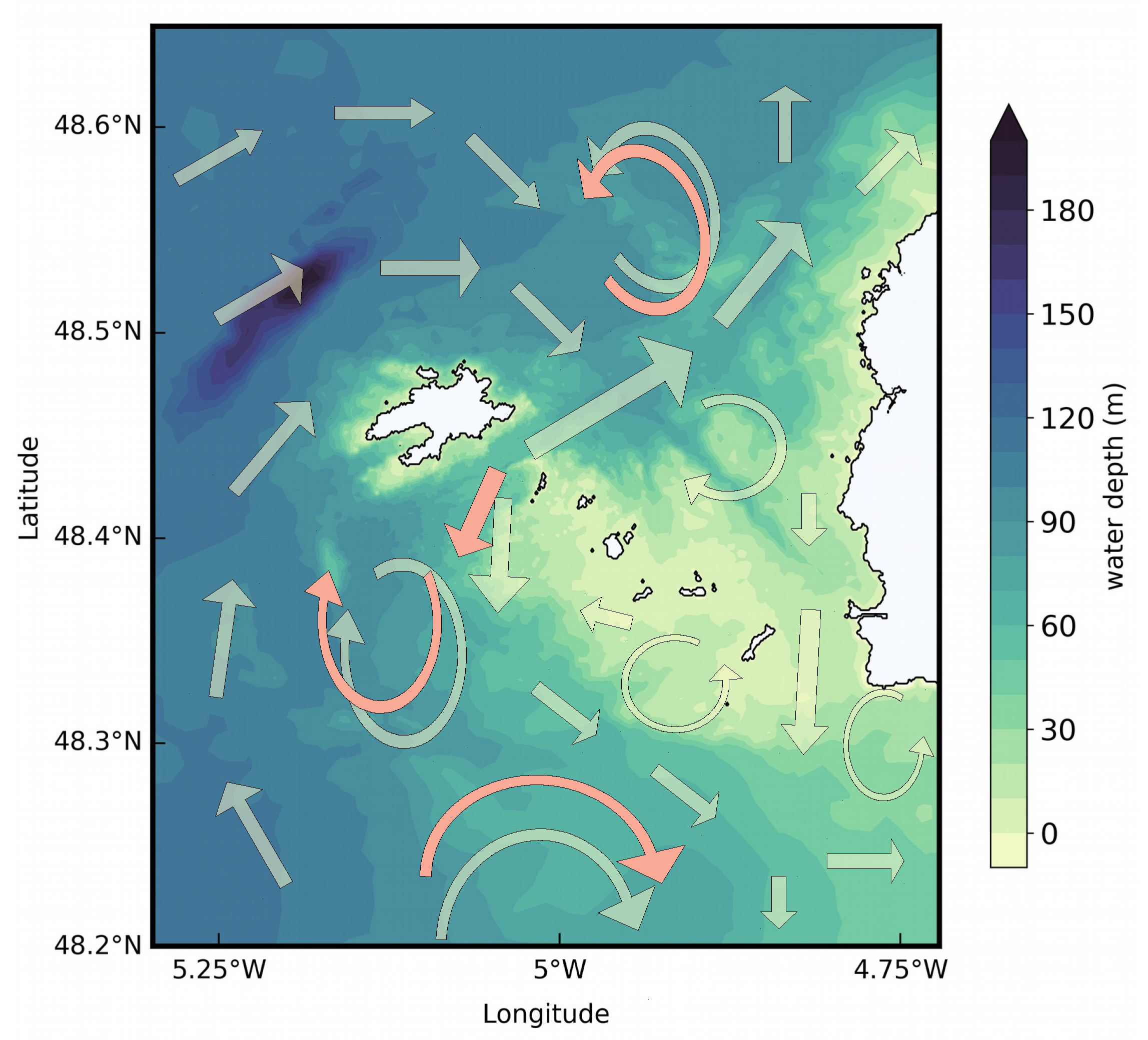
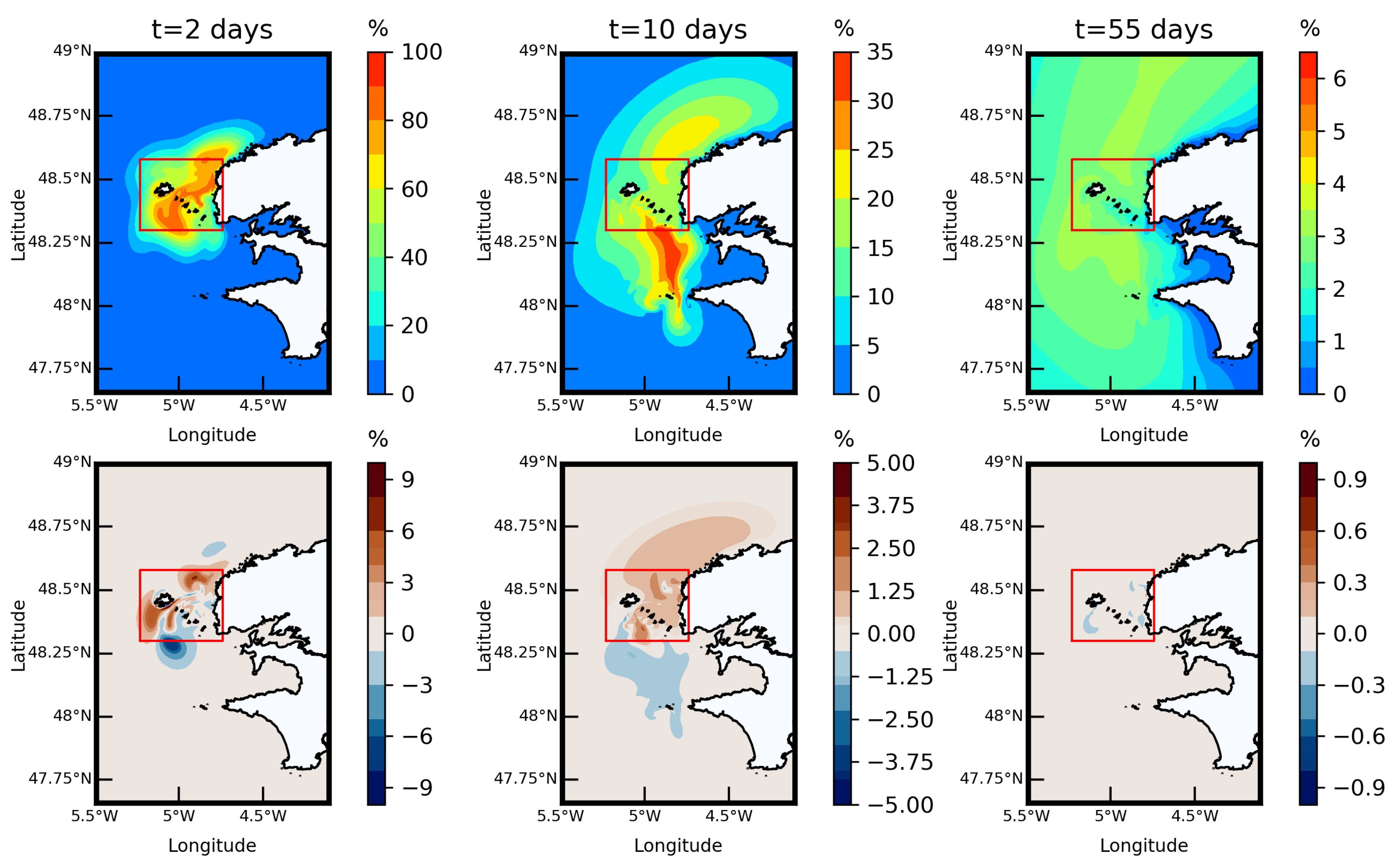
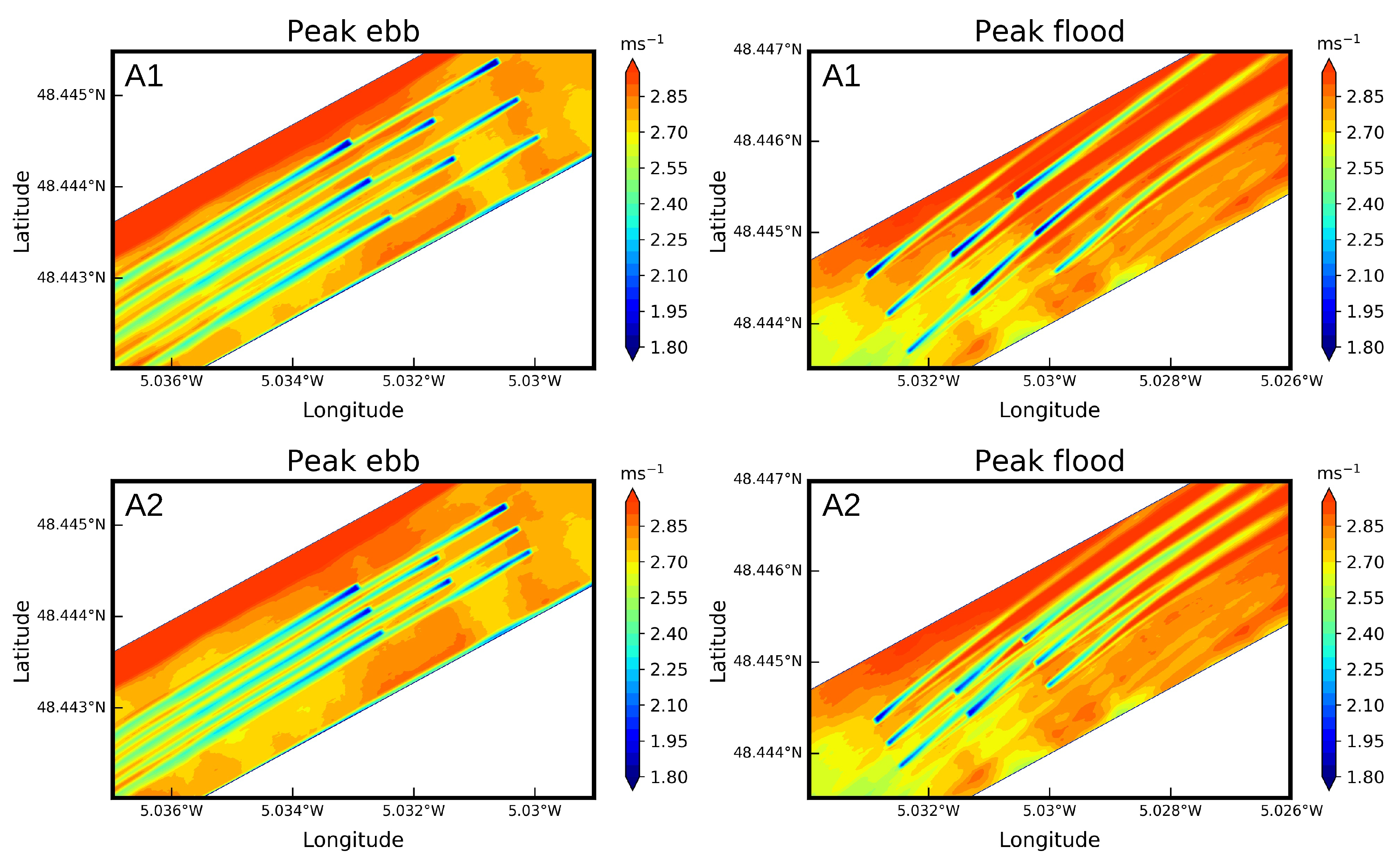
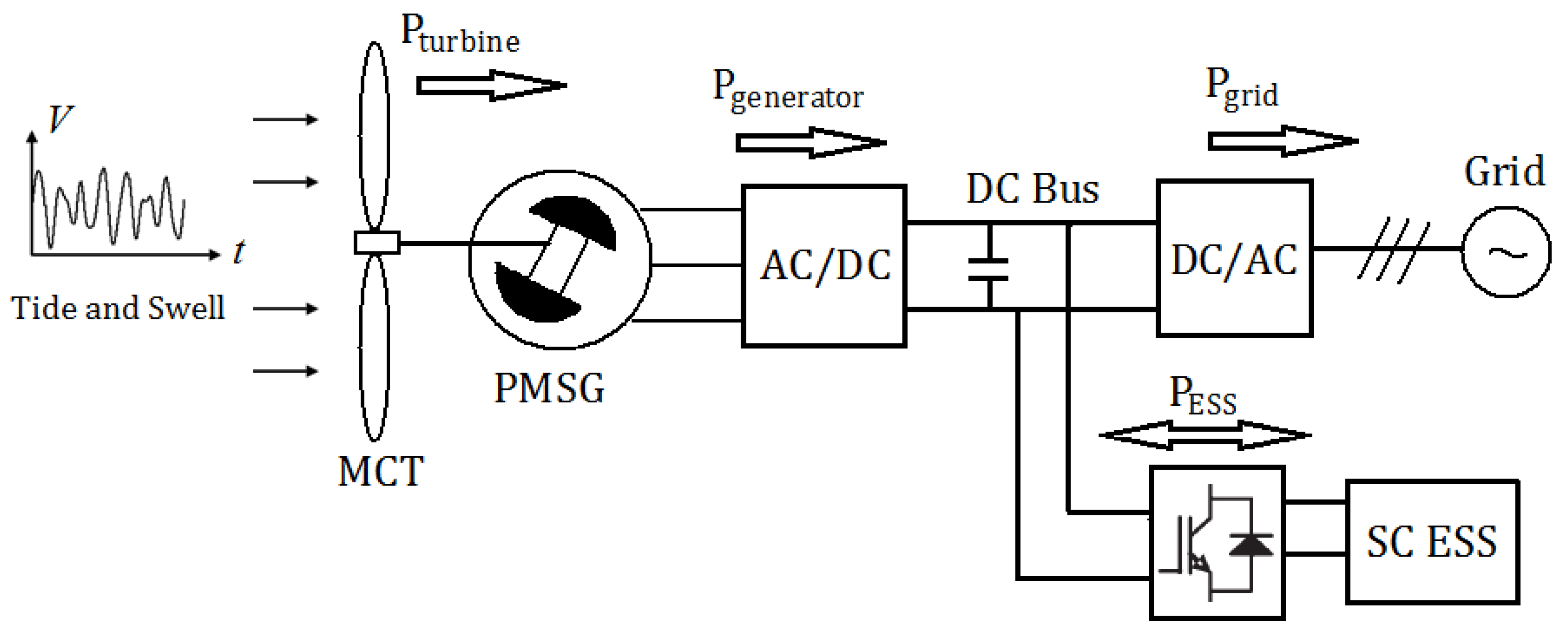
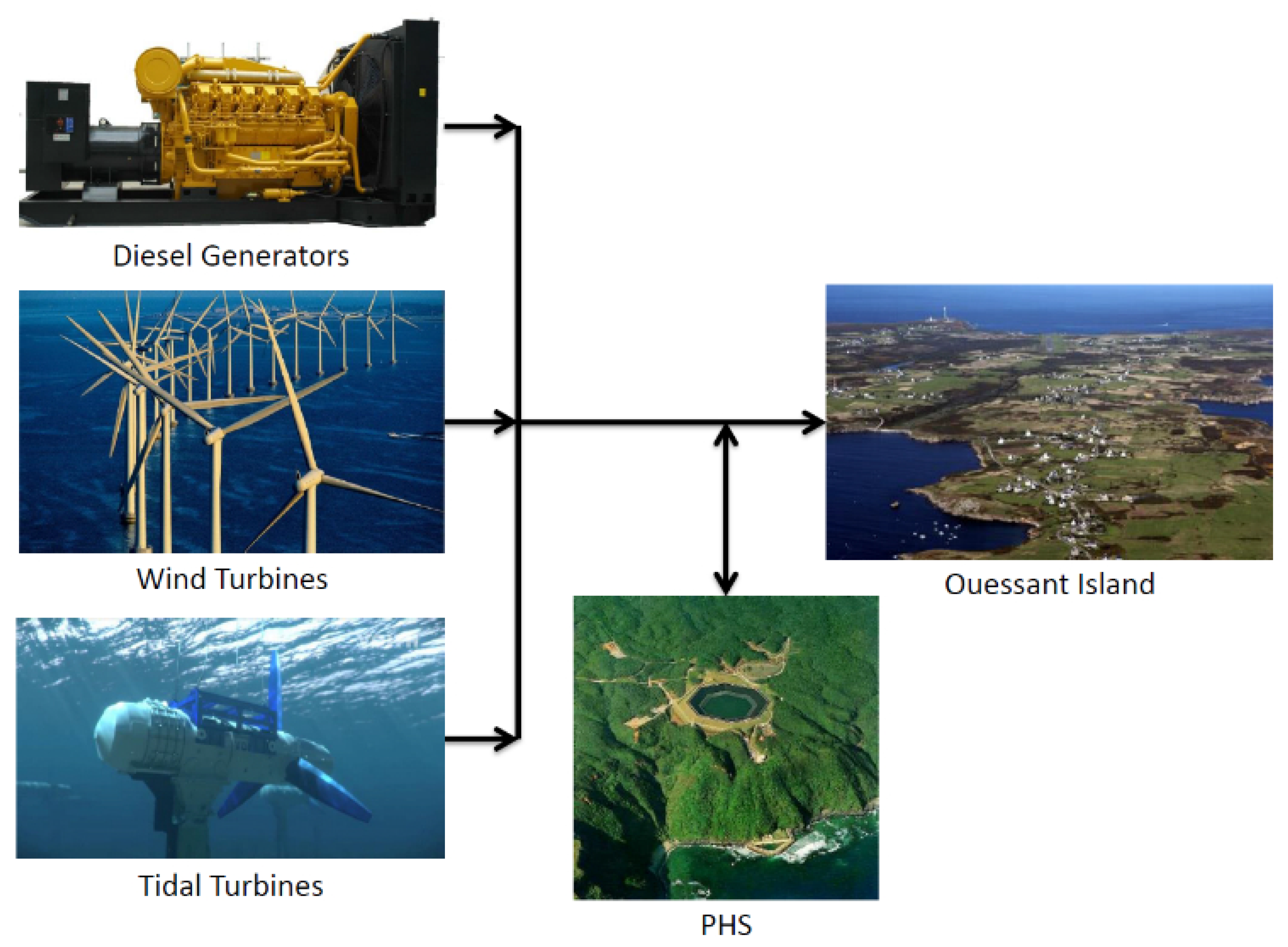
| Instrument | Points | Coordinates | Water Depths | Periods | |
|---|---|---|---|---|---|
| Types | Lon. | Lat. | (m) | of Measurements | |
| C1 | 53 | 19 March 1993 → 2 April 1993 | |||
| Current | C2 | 29 | 14 May 1993 → 11 June 1993 | ||
| Meters | C3 | 80 | 12 August 2012 → 23 August 2012 | ||
| C4 | 110 | 26 February 2006 → 9 March 2006 | |||
| Wave | W1 | 60 | 15 October 2005 → 29 November 2019 | ||
| Buoys | W2 | 25 | 2 October 2012 → 17 April 2014 | ||
| Purposes | Models | Types of Mesh | 2D/3D | Spatial Res. Reached | References |
|---|---|---|---|---|---|
| Harmonic database | MARS | Regular | 2DH | 250 m | [10] |
| Harmonic database | Telemac 2D | Unstructured | 2DH | 50 m | [3] |
| Resource and impact studies | Telemac 2D | Unstructured | 2DH | 50 m | [22] |
| Assessment of waves effects | Telemac 3D | Unstructured | 3D | 50 m | [23] |
| Turbines impact on the Lagrangian circulation | Telemac 2D | Unstructured | 2DH | 50 m | [24] |
| Turbines impact on water renewal | Telemac 2D | Unstructured | 2DH | 50 m | [12] |
| Turbine wake interactions | ROMS | Regular | 3D | 1 m | [25] |
| Array | Peak Ebb | Peak Flood | Difference |
|---|---|---|---|
| Layout | (MW) | (MW) | |
| A1 | 4.44 | 3.80 | |
| A2 | 4.53 | 4.47 |
Publisher’s Note: MDPI stays neutral with regard to jurisdictional claims in published maps and institutional affiliations. |
© 2020 by the authors. Licensee MDPI, Basel, Switzerland. This article is an open access article distributed under the terms and conditions of the Creative Commons Attribution (CC BY) license (http://creativecommons.org/licenses/by/4.0/).
Share and Cite
Guillou, N.; Charpentier, J.-F.; Benbouzid, M. The Tidal Stream Energy Resource of the Fromveur Strait—A Review. J. Mar. Sci. Eng. 2020, 8, 1037. https://doi.org/10.3390/jmse8121037
Guillou N, Charpentier J-F, Benbouzid M. The Tidal Stream Energy Resource of the Fromveur Strait—A Review. Journal of Marine Science and Engineering. 2020; 8(12):1037. https://doi.org/10.3390/jmse8121037
Chicago/Turabian StyleGuillou, Nicolas, Jean-Frédéric Charpentier, and Mohamed Benbouzid. 2020. "The Tidal Stream Energy Resource of the Fromveur Strait—A Review" Journal of Marine Science and Engineering 8, no. 12: 1037. https://doi.org/10.3390/jmse8121037
APA StyleGuillou, N., Charpentier, J.-F., & Benbouzid, M. (2020). The Tidal Stream Energy Resource of the Fromveur Strait—A Review. Journal of Marine Science and Engineering, 8(12), 1037. https://doi.org/10.3390/jmse8121037








